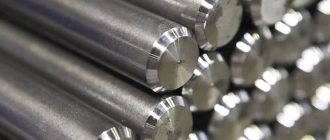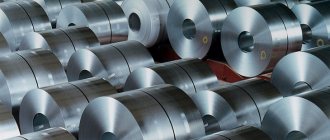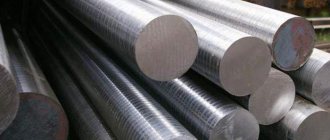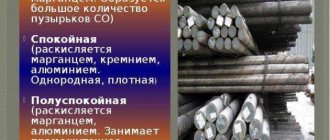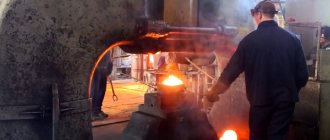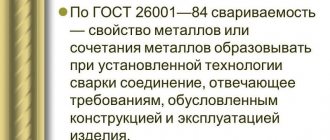Types and grades of steel
Steel is an alloy of iron and carbon with other elements, the carbon content in it is no more than 2.14%.
The most general characteristic is that steel is classified according to its chemical composition:
- carbon steel (Fe – iron, C – carbon, Mn – manganese, Si – silicon, S – sulfur, P – phosphorus). Based on carbon content, it is divided into low-carbon, medium-carbon and high-carbon. Carbon steel is designed for statically loaded tools.
- alloy steel - alloying elements are added: nitrogen, boron, aluminum, carbon, phosphorus, cobalt, silicon, vanadium, copper, molybdenum, manganese, titanium, zirconium, chromium, tungsten, nickel, niobium.
According to the production method and impurity content, steel differs:
- ordinary quality steel (carbon less than 0.6%) – corresponds to GOST 14637, GOST 380-94. St0, St1, St2, St3, St4, St5, St6. The letters “St” indicate ordinary quality steel, the numbers indicate the marking number depending on the mechanical properties. It is the cheapest steel, but inferior in other qualities.
- high-quality steel (carbon or alloy) - GOST 1577, carbon content is indicated in hundredths of % - 08, 10, 25, 40, the degree of deoxidation and the nature of solidification can additionally be indicated. High-quality carbon steel has high ductility and increased weldability.
Low-carbon high-quality structural steels are characterized by low strength and high ductility. Parts for cold stamping are made from sheet steel 08, 10, 08kp. Bolts, screws, nuts, axles, hooks, studs and other parts for non-essential purposes are made from steels 15 and 20.
Medium-carbon quality steels (st. 30, 35, 40, 45, 50, 55) are used after normalization and surface hardening for the manufacture of parts that have high strength and core toughness (axles, screws, bushings, etc.)
Steel 60 - steel 85 have high strength, wear resistance, and elastic properties. Crane wheels, rolling rolls, compressor valves, springs, leaf springs, etc. are made from them.
- high quality - complex chemical composition with low phosphorus and sulfur content - according to GOST 19281.
Steel is also divided by application:
- construction steel - carbon steel of ordinary quality. Has excellent weldability. The number indicates the conditional number of the steel composition according to GOST. The higher the reference number, the higher the carbon content, the higher the strength of the steel and the lower the ductility.
- structural steel - GOST 1050
Carbon-based high-quality structural steels are used in mechanical engineering, for welded, bolted structures, for roofing work, for the manufacture of rails, railway wheels, shafts, gears and other parts of forklifts. The numbers in the marking indicate the carbon content in tenths of a percent.
Structural alloy steels are used for tractor tracks, the manufacture of springs, leaf springs, axles, shafts, automobile parts, turbine parts, etc.
- tool steel - used for cutting tools, high-speed steel for cold and hot deformation of materials, for measuring instruments, for the production of hammers, chisels, chisels, cutters, drills, files, razors, rasps.
- alloy steel is a universal steel containing a special impurity. Silicon content more than 0.5%, manganese more than 1%. GOST 19281-89. If the content of the alloying element exceeds 1 - 1.5%, then it is indicated by a number after the corresponding letter.
- low-alloy steel - where alloying elements are up to 2.5% (09G2S, 10HSND, 18KhGT). Low-alloy steel can be used in conditions of the far north, from -70 degrees C. Low-alloy steel is distinguished by greater strength due to a higher yield strength, which is important for critical structures.
- medium alloyed (2.5 -10%),
- highly alloyed (from 10 to 50%)
- special purpose steel - steel with special physical properties. It is used in the electrical industry and precision shipbuilding.
The weldability of steel is affected by the degree of its deoxidation. According to the degree of deoxidation, steel is classified:
- mild steel (st3sp) - completely deoxidized with a minimum content of slag and non-metallic impurities,
- semi-quiet steel (st3ps) - quality characteristics are similar to calm steel,
- boiling steel (08kp) - unoxidized steel with a high content of non-metallic impurities.
Depending on the standardized characteristics, steel is divided into categories: 1, 2, 3, 4, 5. Categories indicate chemical composition, tensile mechanical properties, impact strength).
Other classification features
By deoxidation method
There are three types of steels: boiling, semi-calm, and calm. With equal carbon content, these alloys have the same strength characteristics and different ductility characteristics.
- Manganese is used to deoxidize boiling steels. They are characterized by: significant chemical and structural heterogeneity of the ingot. Due to their low silicon content, steels can be cold formed. Not used to create products for use in cold climates.
- Semi-calm (ps). They are deoxidized with manganese and in a ladle with aluminum.
- Calm (sp). Silicon, manganese, and aluminum are used for deoxidation. The yield is approximately 85%. The ingot is characterized by a dense, homogeneous structure.
By quality
- Carbon steels are of ordinary quality - their marking is carried out according to GOST 380-2005. They are designated by the index St and a number - the brand number. The higher the number, the higher the carbon content, the greater the hardness and the less ductility. At the end there is a designation for the deoxidation method: kp, ps, sp. Used in the manufacture of non-critical building structures, fasteners, pipes, sheets, flanges.
- High-quality carbon structural steels are designated by double-digit numbers equal to the amount of carbon in hundredths of a percent. At the end, the deoxidation index is indicated (except for mild steels).
What are carbon steels?
Carbon steels, which, depending on the main scope of application, are divided into structural and instrumental, practically do not contain alloying additives. These steels are also distinguished from conventional steel alloys by the fact that their composition contains a significantly smaller amount of such basic impurities as manganese, magnesium and silicon.
The content of the main element - carbon - in steels of this category can vary within fairly wide limits. Thus, high-carbon steel contains 0.6–2% carbon, medium-carbon steel – 0.3–0.6%, low-carbon steel – up to 0.25%. This element determines not only the properties of carbon steels, but also their structure. Thus, the internal structure of steel alloys containing less than 0.8% carbon consists predominantly of ferrite and pearlite; with increasing carbon concentration, secondary cementite begins to form.
Carbon steels with a predominant ferritic structure are characterized by high ductility and low strength. If cementite predominates in the steel structure, then it is characterized by high strength, but at the same time it is also very brittle. When the amount of carbon increases to 0.8–1%, the strength characteristics and hardness of carbon steel increase, but its ductility and toughness significantly deteriorate.
The quantitative carbon content also has a serious impact on the technological characteristics of the metal, in particular on its weldability, ease of processing by pressure and cutting. Low-carbon steels are used to make parts and structures that will not be subject to significant loads during operation. The characteristics of medium-carbon steels make them the main structural material used in the production of structures and parts for the needs of general and transport engineering. Due to their characteristics, high-carbon steel alloys are optimally suited for the manufacture of parts that are subject to increased wear resistance requirements, for the production of impact punches and measuring tools.
Carbon steel, like any other category of steel alloy, contains various impurities: silicon, manganese, phosphorus, sulfur, nitrogen, oxygen and hydrogen. Some of these impurities, such as manganese and silicon, are useful; they are introduced into the steel composition at the stage of its smelting in order to ensure its deoxidation. Sulfur and phosphorus are harmful impurities that impair the quality characteristics of the steel alloy.
Although it is believed that carbon and alloy steels are incompatible, microalloying can be performed to improve their physical, mechanical and technological characteristics. For this purpose, various additives are introduced into carbon steel: boron, titanium, zirconium, rare earth elements. Of course, with the help of such additives it will not be possible to make stainless steel out of carbon steel, but they can significantly improve the properties of the metal.
Properties of carbon steels
When considering a particular brand, the engineer is interested in the chemical composition not in itself, but as a direct indication of possible physical and mechanical properties. And those, in turn, reflect the range of functions that are characteristic of the material.
And with an eye to this relationship, we can make the statement that each grade of carbon steel is unique in its own way, because it has its own, unique set of characteristics.
Strength characteristics
The first parameter that is taken into account when designing any structure is the ability of the material to resist existing loads. This is a comprehensive feature that will include:
- tensile strength - the size of the force load under which the metal is destroyed;
- yield strength - the size of the force load at which the metal begins to deform;
- impact strength - the ability to resist sudden force impacts;
- relative elongation at break - how much the metal will elongate before it finally “breaks” under the influence of a radical force load exceeding its tensile strength;
- hardness - the ability to resist the penetration of another solid body.
All these indicators are closely related to each other. And based on their assessment, one can easily predict how the material will behave in work.
The relationship between the individual mechanical characteristics of the alloy is not always direct. For example, the tensile strength is always 1.7..2.2 times greater than the yield strength. But the higher the tensile strength of the alloy, the lower the relative elongation at break it will often show.
The mechanical characteristics of carbon steels increase with the carbon content. This element is the main feature of all the capabilities of the alloy.
The table below shows the approximate indicators of different categories of steels in the “raw” state.
| Carbon steel category | Tensile strength | Elongation at break | Surface hardness |
| Low carbon steels | 255…450 MPa | 20…34% | 101…179 HB |
| Medium carbon steels | 450…560 MPa | 16…24% | 132..207 HB |
| High carbon steels | 650…820 MPa | 11..16% | 187…269 HB |
Heat treatment allows you to change the original properties. For example, hardening provides tool steels with an increase in strength over 1570 MPa with a surface hardness of about 59...64 HRC (600..668 HB). The relative elongation at break is reduced to 7%.
Impact strength is rarely considered as the main parameter of the mechanical properties of steel. But it can provide more information, complementing the picture and dotting the “I”.
Impact strength is measured as a reflection of how much energy must be applied to break a piece of material of a certain area. Toughness differs from ultimate strength in that the researcher evaluates the behavior of the metal not under conditions of a steadily applied load, but under conditions of a sharp and sudden impact.
For carbon steels, impact strength will depend, among other things, on the structural state of the alloy:
- after hot rolling (raw metal) - 14..28 J/cm2;
- after annealing - 32..72 J/cm2;
- after quenching and tempering - 110..164 J/cm2.
In a functional sense, this parameter also reflects the tendency of a material to crack under the application of stationary, impulse or vibration loads.
Corrosion resistance
The weak point of all carbon steels is their susceptibility to corrosion and oxidation. All brands, without exception, react very sharply and painfully to contact with water, open air and saturated steam.
In industrial alloys, corrosion resistance is obtained due to the chemical inertness of the base components of the material. So we can safely immerse brass in water, since it is not harmful to copper and zinc.
In the manufacture of corrosion-resistant steels, chromium is used as the main alloying component. As soon as its specific share in the alloy exceeds 10%, this element will inhibit the oxidation of iron. The work of chromium is complemented and enhanced by the presence of nickel (5% and above), copper and molybdenum. In rare cases, 1..2% titanium and a tiny proportion of rare earth metals are added.
There are no significant alloying additives in carbon steels, although chromium and nickel are still present - but not more than 0.25%. Therefore, this category of industrial alloys is vulnerable to corrosion like no other.
Visual experiments were carried out to show the degree of rust spread on unalloyed steels. The workpiece was immersed in a stream of hot water (60°C) for 3000 hours. The oxidation rate reached 0.65 grams of metal per 1 square meter of surface in 1 hour. The damage extended 0.24 mm deep.
To increase the corrosion resistance of carbon steels, protective coatings are used:
- painting on the ground;
- chrome plating;
- galvanizing;
- nickel plating;
- cadmium plating
It is also acceptable to use chemical oxidation and phosphating technologies to avoid contact with the environment.
Wear resistance
The ability to successfully resist mechanical wear of surfaces is one of the necessary functions if the part will work in constant contact with another part or with a flow of liquid or gaseous medium passing over its surface at a certain speed.
Wear resistance is achieved by increasing the hardness of the surface layers of the material and smoothing out the microrelief of irregularities. To do this, products made of carbon steel are subjected to thermal or chemical-thermal treatment, and then polished to a shine.
The most significant technologies:
- hardening - for medium and high carbon grades;
- carburization and cyanidation - for low-carbon ones;
- Nitrocementation is for everyone.
If carburization is the process of saturating surface layers with external carbon, when “on the crust” low-carbon steel is superior to high-carbon steel, then nitrocarburization is simultaneous saturation with carbon and nitrogen. In this case, the surface hardness reaches 58..64 HRC, and in addition there is minimal resistance to corrosion. The best results in nitrocarburizing are achieved on alloy steels, but carbon steels also show a significant improvement in properties.
Cyanidation also involves exposing steel to nitrogen and carbon, but the entire process takes place in baths of cyanide salts. At the same time, using the modes, you can smoothly control the proportion of carbon and nitrogen in the final result.
Temperature resistance
The permissible operating range of carbon steels is from −100 to +350°C. Beyond these values, the material begins to rapidly lose its strength. This is due to the fact that in its pure form the alloy of iron and carbon is unstable with respect to temperature.
Resistance to heating or cooling must be enhanced by adding molybdenum, manganese, silicon, large doses of chromium and nickel. But in carbon steels, the alloying elements are in too small a volume to have a significant effect.
A significant drop in strength properties begins at +400°C. Here the alloy loses 15...25% of its original value at room temperature. When crossing the border to +500°C, carbon steel loses 40...50% of its strength.
You can see a direct relationship with the conditions of heat treatment: minimal tempering (softening, stress relief, structure stabilization) of such grades occurs at a temperature of +400°C. High tempering (full return to the “raw” state) - at +600°C. Accordingly, even hardened carbon steels cannot operate effectively when heated above the temperature when the metal is tempered.
Manufacturability in processing
The manufacturability of a material is defined as how convenient and trouble-free it is to process it industrially. Based on the assessment results, the alloy is recognized as technologically advanced - if it can be used to easily achieve your goals - or non-technological - if thousands of difficulties await along the way.
Carbon steels belong to the category of high-tech industrial materials. For many years, all the methods and methods have been known to control the properties of these alloys and achieve the desired results.
These brands perceive:
- mechanical processing (cutting) - without restrictions. They can be successfully turned, drilled and milled without additional conditions;
- processing by plastic deformation - without restrictions. They are stamped in cold and hot states, subjected to forging, deep drawing, rolling and bending;
- welding processes - here it is necessary to focus on the specific carbon content. The more it is, the more attention the organization of welding requires. Low-carbon steel can be welded “on the knee”, without any flux or shielding gas. But medium-carbon steel will require preheating and careful control of penetration, and after completion of work - mandatory normalization or annealing of the entire structure;
- heat treatment - depending on carbon content. The alloys lend themselves well to hardening, carburization, nitrocarburization and cyanidation. All brands, without exception, can be annealed, tempered and normalized.
Carbon steels account for over 70% of all cases of choosing steel as a structural material. This fact is already proof of the high manufacturability of this category of alloys.
In the overall strategy for industrial applications, it is carbon steels that engineers turn to first. The coverage area of alloy grades begins where carbon grades simply cannot work.
Types of carbon steels by carbon content
Carbon is the main element of carbon steel, and its content in the alloy can vary within a fairly wide range: from 0.25% to 2%.
Low carbon steels with carbon content up to 0.25%
Most low-carbon steel is produced in the form of cold-rolled and annealed strips and sheets. Its properties vary depending on the content of basic chemical elements:
- C up to 0.1%, Mn less than 0.4%. The material has a high ability to hot deformation and cold drawing. Used in the production of wire, very thin sheets, containers and car bodies.
- C from 0.1% to 0.25%. This material is stronger and harder than the one described above, and its ability to deform is lower. Often used for the production of parts with a cemented surface layer.
- C about 0.25%, Mn and Al up to 1.5%. High viscosity material. Suitable for metals intended for forging, stamping, seamless tube and boiler sheet production.
- C about 0.15%, Mn less than 1.2%, Pb up to 0.3% (or without), minimal amount of Si. It is used in mass production on automatic lines of parts that are not designed to withstand severe mechanical and temperature loads.
Medium carbon steels with carbon content from 0.2% to 0.6%
Typically, in medium-carbon steels the manganese content is at the level of 0.6-1.65%. They are suitable for the production of products that will be operated under high loads. Can be forged. Suitable for mechanical engineering.
High carbon steels with carbon content from 0.6% to 2%
With an increase in the amount of carbon to 1%, high-carbon steel becomes stronger and harder, while at the same time the limits of its fluidity and ductility decrease. A further increase in carbon by more than 1% leads to the beginning of the formation of a coarse network of secondary martensite, which reduces the strength of the material.
High carbon steel is characterized by high cost, low ductility and poor weldability. This material has a limited scope of application - it is used for the production of cutting tools and high-strength wire.
Basic properties of steel
When ordering a material, you need to consider what properties the steel must have in order to be suitable for a specific application. If you do not understand this feature, there is a risk of purchasing raw materials that do not meet the strength, level of corrosion protection, weldability quality and other characteristics.
Let's consider the main characteristics of the material.
Mechanical
Shows which processing options can be selected and where to use them. There are several main parameters:
- Strength. Shows how much load can be applied to a part until the first signs of failure appear. For each grade of material, this parameter is indicated, as well as the yield strength.
- Tensile strength. Indicates that the material is protected from mechanical stress.
- Yield limit. Gives an idea of the stretchability of the material. This helps to understand how far the material can be stretched until the process continues even when the load is no longer applied.
- Plastic. So that the material can be used in the manufacture of various types of parts and workpieces. This characteristic helps the raw material change shape; it is prescribed to determine the parameters of the relative bending angle and elongation.
- Impact strength. Directly related to the limits of dynamic loads. The characteristic indicates how much impact a finished product or workpiece can withstand before it begins to completely collapse.
- Hardness. Shows the maximum load over the area before indentation occurs. It can be determined by different methods, both Brinell and Vickers.
Physical
The parameters make it clear whether it is possible to use steel in construction or various fields of industry. There are three significant central indicators:
- Density. The specification encodes what mass of steel is contained in the specified volume. The higher the strength, the greater the protection from deformation, strong pressure and other potential threats.
- Thermal conductivity. The parameter gives an idea of how quickly heat is transferred through the workpiece. The parameter is very important for industry, for example, in the manufacture of radiators or pipes for heating mains.
- Electrical conductivity. Allows you to assess the safety of using the material in places where there is a risk of electric shock. The alloy can also be selected for installation in areas where its conductive characteristics are important.
Chemical
The entire set of parameters gives an idea of how the material will behave in different temperatures or environments with varying degrees of aggressiveness. There are four main parameters:
- Oxidability. The oxidation process is caused by contact of the metal with oxygen and can be stimulated by an increase in temperature. The level of oxidation is affected by the carbon content and the environment in which the products are used. The greater the exposure to oxidation, the faster rust will appear on the surface.
- Corrosion protection. Specified for different environments. May change when used outdoors or when in contact with water or soil.
- Heat resistance. Helps to understand at what heating corrosion begins to gradually develop on the metal. The characteristic is directly related to oxidability.
- Heat resistance. It differs from heat resistance in that it does not affect corrosion resistance and scale protection, but the strength itself. Knowing the parameters will help you understand to what temperature the workpiece will heat up before it can be broken or deformed.
Technological
Shows the possibility of processing using various technologies. Central parameters:
- Ductility. The higher it is, the faster it will be possible to shape it under constant external mechanical influence.
- Fluidity. If this parameter is at a high level, the molten material will be able to better fill voids.
- Weldability. Helps to connect various workpieces together. It varies depending on the type of welding used and the alloy itself.
- Machinability. Steel can be processed with different types of cutting tools to create rolled metal products and parts with different parameters and areas of application.
Types of carbon steel by degree of deoxidation
The degree of deoxidation is another factor influencing the division of carbon steels into types. There are 3 types in total: calm, semi-calm and boiling.
Quiet steels are distinguished by a more uniform internal structure - their dewetting is carried out by adding ferrosilicon, ferromanganese and aluminum to the molten metal. There is practically no ferrous oxide in the composition. The structure is fine-grained due to residual aluminum. The result is high-quality metal, suitable for the manufacture of the most critical parts and structures. However, alloys of this type have a significant drawback - their smelting is quite expensive.
Boiling carbon steels are a cheaper, but also lower quality alternative to calm alloys. When smelting them, a minimum amount of special additives is used, and the deoxidation process in the furnace is not completed, as a result of which dissolved gases are present in the structure of boiling carbon steel, which negatively affect its characteristics.
Semi-quiet steels occupy an intermediate position both in properties and in the degree of deoxidation. Before pouring into the molds, a small amount of deoxidizing agents is added to the composition - thanks to this, the metal hardens practically without boiling, while the process of gas evolution continues in it. As a result, there are fewer gas bubbles in the structure of semi-quiet carbon steel than in boiling steel. Most often, semi-mild carbon steels are used as structural materials.
Types of carbon steel by type and quality
Carbon steel is produced using various technologies, which leads to their separation according to quality characteristics. There are two types of steel:
- structural;
- instrumental.
Structural carbon steel contains up to 0.65-0.70% carbon (as an exception, structural steel containing 0.85% carbon is also produced). It is quite durable, resists impacts well, and is also well processed.
Structural carbon steels are widely used in industry: they are used for the manufacture of structural elements for mechanical engineering and construction purposes, parts for equipment, fasteners and much more.
It is also divided according to quality into 3 types:
- Ordinary quality – steel of wide application, which is suitable for the production of fasteners, pipes, building structures, sheet metal, etc.
- High quality - used for the manufacture of boilers, locomotive and carriage axles, wire, etc.
- High-quality - suitable for parts that require high ductility and impact resistance, used under high pressure, such as pipes, bolts, screws, gears, etc.
Tool carbon steel has a carbon content of 0.7% and higher. This type of steel is hard and durable, making it suitable for tool making. It is divided into high-quality (sulfur 0.03%, phosphorus 0.035%) and high-quality (sulfur 0.02%, phosphorus 0.03%).
Application of carbon steel
Due to their high strength, good machinability, durability and comparative cheapness, carbon steels have found their use in many sectors of the national economy.
They are especially popular in mechanical engineering, which is due to the ability of the metal to resist active loads, as well as high fatigue limits. Thus, carbon steel acts as the main material for the production of:
- flywheels;
- gears of reducers;
- connecting rod bodies;
- crankshafts;
- plunger pump pistons.
Carbon alloys are used to produce technological equipment for the light woodworking industry. In all these cases, structural carbon steels are used. After carburization, this type of metal is used to create wear-resistant parts, the operation of which will be accompanied by significant dynamic loads.
Based on low and medium carbon steel, the following products are produced:
- corners;
- channels;
- pipes;
- I-beams and other profiles
The initial properties of structural carbon steels must be increased by heat treatment (hardening).
The production of tools for various purposes is based on the use of tool steel alloys that contain 0.65–1.32% carbon:
- hammers, cores, screwdrivers, chisels, forging tools, scythes (grade of tool carbon steel U7 and U7A);
- scissors, chipper knives, hand carpentry tools, frame saws (grade U8, U8A);
- drills, small-diameter cutters, band saws, reamers (grade U10, U10A);
- turning wood cutters, hacksaw blades for metal, files, engraving tools (grade U12, U13).
Tool carbon steels are used for the production of measuring instruments. To obtain a small part with a linear dimensional accuracy of several hundred millimeters, the workpiece must not be heated or deformed as a result of the pressure exerted by the cutting tool.
The use of carbon steels of ordinary quality is in demand in construction; some grades are used in mechanical engineering and shipbuilding.
